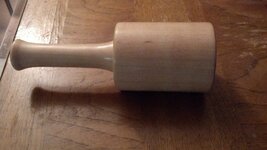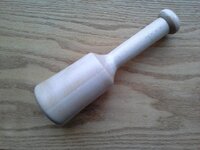You are using an out of date browser. It may not display this or other websites correctly.
You should upgrade or use an alternative browser.
You should upgrade or use an alternative browser.
Pen disasembly mallet
- Thread starter Adillo303
- Start date
Signed-In Members Don't See This Ad
See more from Adillo303
Signed-In Members Don't See This Ad
Looks nice - what are the dimensions?
thewishman
Member
That looks like a nice mallet.
I use metal transfer punches and they might ding up that guy.
I use metal transfer punches and they might ding up that guy.
Adillo303
Member
Yeah Chris, I use the same thing. You said exactly what my wife said.
I suppose it will happen, but then, when making a mallet that is what is gonna happen anyway.
Here is the carvers mallet.

It weighs 20.0 oz, the mini is 8.7 oz.
The mini is 8 1/2" long the head is 4", the handle is 4 1/2", the head is about 2 1/4" diameter at the big end.
The material is 3 pieces of 5/4 hard white maple laminated.
I suppose it will happen, but then, when making a mallet that is what is gonna happen anyway.
Here is the carvers mallet.

It weighs 20.0 oz, the mini is 8.7 oz.
The mini is 8 1/2" long the head is 4", the handle is 4 1/2", the head is about 2 1/4" diameter at the big end.
The material is 3 pieces of 5/4 hard white maple laminated.
Last edited:
monophoto
Member
Wooden mallets are really ideal for use in disassembling pens - they are a bit more 'responsive' than dead-blow mallets, while not nearly as hard and unforgiving as a steel hammer.
Perhaps what is needed to to turn wooden caps to fit over the end of the metal transfer punches.
But it's not hard to rechuck them and refresh the surface if they get dinged.
But it does kinda say something when you can make a tool that is just too pretty to use.
Perhaps what is needed to to turn wooden caps to fit over the end of the metal transfer punches.
But it's not hard to rechuck them and refresh the surface if they get dinged.
But it does kinda say something when you can make a tool that is just too pretty to use.
plantman
Member
I have always used a homemade brass hammer on any surface I don't want to mushroom. I also turned a light weight wooden mallet, and a Lignum Vitae carvers mallet. Nice loking turning. Jim S
TimS124
Member
I use a similar shop-made wooden mallet for disassembling pens.
I also use the metal transfer punches.
To minimize damage to the mallet, I use the end-grain section of the head as the point of impact.
Yeah, that's not where most would expect impact to occur. End grain is much tougher than edge grain so smacking a metal transfer punch doesn't make a huge mess.
This also puts 100% of the mallet's mass directly inline with the transfer punch and allows me to tap more gently.
It provides a wider and flatter target to hit the transfer punch with vs. making contact via the side of a cylinder when swinging a mallet by the handle.
The one caveat is I wouldn't do that with a Red Oak mallet. Red Oak likes to split and smacking its end grain might tempt it too much.
White Oak won't do that…it does NOT like to split. Elm would be great (best way to split it is with a chainsaw or explosives).
I'm using Ash currently and have had no problems. I've used Maple as well with fine results. Poplar is a bit soft and light…works but it's not pretty so at least you won't mind if it gets banged up.
Shop-made mallets are a good project for learning a new tool…try making one entirely with a skew (or whatever other tool you might not be entirely comfortable with).
The dimensions aren't overly critical. Handle diameter is whatever feels good to you. Handle length needs to feel good as well.
Any 2.5"x2.5" blank of 10-12" length is a fine starting point. As soon as it's roughed into a cylinder, the head is pretty much done (taper it if you'd like, sand it if you want)….all that remains is shaping the handle and parting it off.
Larger diameters work of course but tend to be heavier in the hand (depending on species used).
I also use the metal transfer punches.
To minimize damage to the mallet, I use the end-grain section of the head as the point of impact.
Yeah, that's not where most would expect impact to occur. End grain is much tougher than edge grain so smacking a metal transfer punch doesn't make a huge mess.
This also puts 100% of the mallet's mass directly inline with the transfer punch and allows me to tap more gently.
It provides a wider and flatter target to hit the transfer punch with vs. making contact via the side of a cylinder when swinging a mallet by the handle.
The one caveat is I wouldn't do that with a Red Oak mallet. Red Oak likes to split and smacking its end grain might tempt it too much.
White Oak won't do that…it does NOT like to split. Elm would be great (best way to split it is with a chainsaw or explosives).
I'm using Ash currently and have had no problems. I've used Maple as well with fine results. Poplar is a bit soft and light…works but it's not pretty so at least you won't mind if it gets banged up.
Shop-made mallets are a good project for learning a new tool…try making one entirely with a skew (or whatever other tool you might not be entirely comfortable with).
The dimensions aren't overly critical. Handle diameter is whatever feels good to you. Handle length needs to feel good as well.
Any 2.5"x2.5" blank of 10-12" length is a fine starting point. As soon as it's roughed into a cylinder, the head is pretty much done (taper it if you'd like, sand it if you want)….all that remains is shaping the handle and parting it off.
Larger diameters work of course but tend to be heavier in the hand (depending on species used).
Fishinbo
Member
Good looking mallet! Very handy and useful around the shop. Can't beat making own tool. Great job!
Adillo303
Member
I have starred to make everything I can. I like the tool and the cost.

